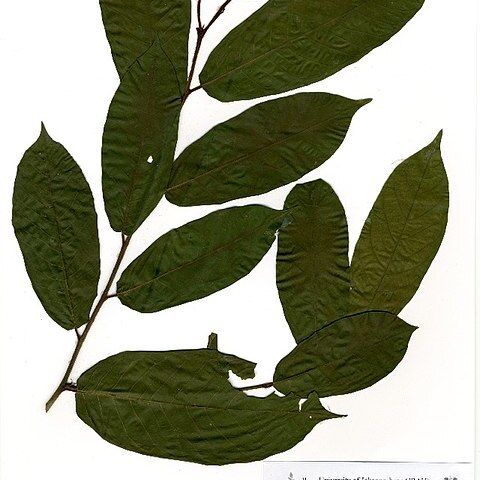Leaves 7.5–31 x 4.3–11 cm, oblong to oblong-lanceolate, or ± elliptic, sometimes oblong-oblanceolate, ± long acuminate to sub caudate at the apex, cordate or subcordate at the base, dark green on upper surface, glaucous and very densely minutely glandular-punctate beneath, glabrous or with scattered dark brown stellate hairs on the lower surface more numerous on midrib especially when young; lateral nerves 15–20(40), prominent below; petiole 7–14 mm long, dark brown tomentose with caducous stellate hairs.
An large evergreen tree. It grows 35 m high. The trunk is 25 m tall and 1.6 m across. The main branches come out parallel to the ground, but high up. The leaves are alternate and simple. They are 20-30 cm long by 6-11 cm wide. The fruit are oval and 3-4 cm long by 2.5-3 cm wide. It opens in 2 valves. It has a red layer around the seed like nutmeg.
Infructescence pendulous, branches becoming stout; fruits subsessile, clustered, 3–4(4.5) x (1.6)2–3(3.8) cm, ellipsoid to oblong or pyriform, splitting vertically into two halves, dark brown tomentose when young, yellowish-orange when ripe; pericarp cartilaginous, 2–10 mm thick, becoming thickly woody-crustaceous when dry.
Evergreen tree up to 22(37) m tall; bole up to 0.7(1.5) m d.b.h., branching high up to produce a small crown; sap copious viscous yellow, turning dark red on exposure to air; branches patent, branchlets slender, ± pendulous at the tips, young growth densely tomentose, the hairs reddish-brown stellate and easily rubbed off.
Inflorescences usually borne on 2-or 3-year old branches, below the leaves, 10–15 cm long, paniculate with flowers many in numerous dense clusters on short lateral branches, densely rusty tomentose; bracts subtending the individual clusters of heads of flowers 2–2.5 x 5 mm, tomentose, deciduous.
Male flowers: perianth c. 1 mm long, deeply 3(5)-lobed; lobes obovate; staminal column 1–1.2 mm long, sometimes twisted; anthers 2–4, exserted on the elongating staminal column, the panicle falling entire after flowering.
Flowers unisexual, scented, the perianth completely covered with dark brown vesiculose hairs; plants dioecious.
Female flowers: perianth lobes broadly ovate; ovary ± 0.5 mm in diameter.
Fruit dehiscent with single seed covered by bright red laciniate aril.
Seed single, 1.5–2.9 x 0.8–1.5 cm, ellipsoid-oblong, dark brown.
Aril fleshy, laciniate almost to the base, red or pink.
Long straight bole up to 15 ft. in girth
Bark exuding red sticky juice when cut
Crown of horizontal, whorled branches
A forest tree up to 120 ft. high

